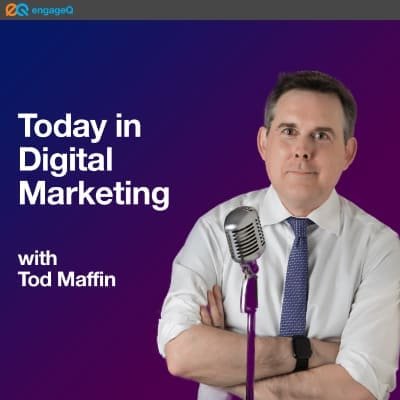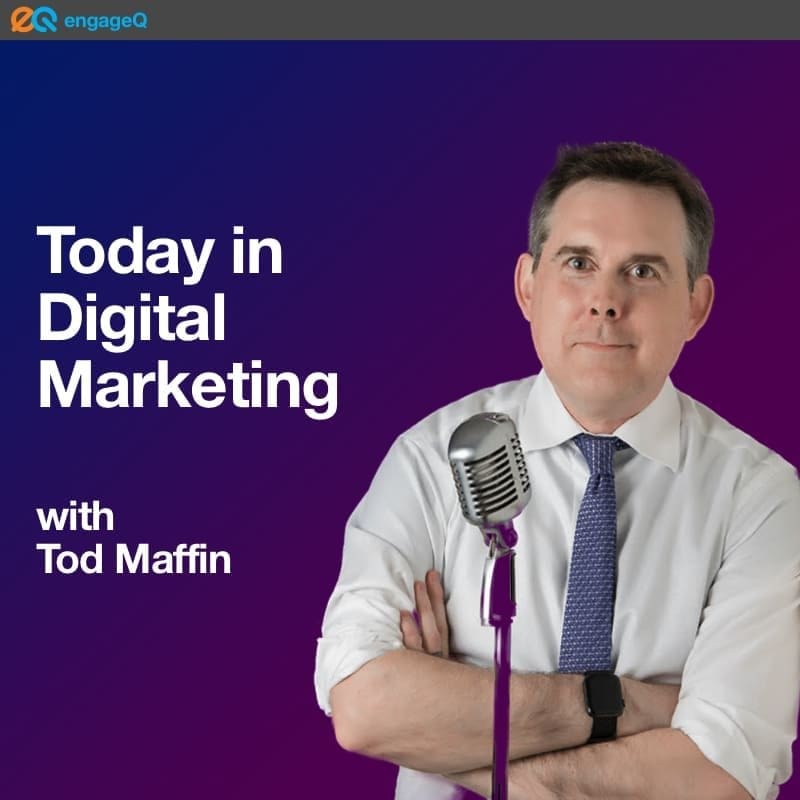Meta Thinks Everything Is AI Now
Did you use AI to make that product image? No? Then why is Meta telling everyone you did?
by Tod Maffin (email • LinkedIn • social media)
Today's News
Meta Applying “AI” Label to More Than You Think
Google’s Local Service Ads Expand to Google Maps
TikTok Influencer Campaigns Going to Billboards
Meta Applying “AI” Label to More Than You Think
Well, I didn’t see this on my “AI takes over everything” Bingo card.
Meta is labelling images as having been “Made with AI” — images which were not, in fact, made with AI. And Techcrunch reports today this has been going on since last month.
One example they showed was of a team winning a cricket league tournament. It’s a real photo, shot with a real camera, held by a real human — but the “Made with AI” label shows up anyway. Interestingly, it’s only visible on mobile apps and not the web.
An Instagram photo of the Kolkata Knight Riders, labeled as “Made with AI”. Image Credit: Instagram (screenshot)
It’s not a bug
And lest you think this is a bug, no — because Meta lives in a parallel universe, this is by design.
Meta’s system seems to be applying the label to any image where AI has even just touched the image — to add a small element with generative fill, for instance.
Pete Souza, the former White House photographer, said all he did was flatten an image into a JPG and that’s all it took for Meta to apply the label.
IMAGE: Pete Souza
Industry standards at fault?
Also, Souza did this photographic work not on Meta’s own platform, but using an Adobe tool. Still, Meta applied the tag.
That’s because Meta is honouring some new technical standards — C2PA and some from the IPTC. This lets software add metadata identifying that some AI took place. This means that Meta can identify when images touch AI from all the major sites: Google, OpenAI, Microsoft, Adobe, Midjourney, and Shutterstock.
This means even if all you do is remove a tree branch from the background using Adobe’s Generative Fill, Adobe will dutifully slip some metadata in, Meta will pick that up, and report that (well, imply that) the whole image was conjured out of thin air.
New language needed?
Obviously this is a language issue, and the industry still hasn’t figured out how to handle granular use of image AI. There’s a big difference between “Made with AI” and “Touched up by AI.”
But do we really even need that?
Removing items from backgrounds has been something photographers have done since the invention of the medium. And even recent technology, like Pixelmator’s Repair tool, can do this and doesn’t use any of the new generation AI.
To be fair, once you tap Meta’s label, it does explain things a bit better. It reads “Generative AI may have been used to create or edit content in this post” — but nobody taps that.
The marketing implications
As for marketers, this might actually become a bigger issue as the months go on. There are national elections happening this year all over the world: France, Ghana, Mozambique, the U.K., Austria… and I feel like I’m missing another one. It’ll come to me.
Elections, of course, are a breeding ground for misinformation, and we may very well see consumers form worsening opinions about generative AI.
Marketers could very well end up having the same labels applied to their images as some big scandals — and that’s no good no matter how hard you or Meta spin it.
Oh…. Venezuela. That’s the one I forgot. July 28th.
Google’s Local Service Ads Expand to Google Maps
If you run Local Service Ads with Google, you might soon start getting more impressions and, maybe, more leads.
Google says it will start showing Local Service ads on Google Maps — first, on the iPhone Google Map app, then others to come after.
The details
An email Google sent to advertisers reads:
One interesting note there is that this change means LSAs will start using reviews from your Google Business Profile, which are generally considered a little more authentic than the ones previously attached to LSAs on their own.
You can’t opt-out
If for some reason you’d rather not have your ad surface in Maps, here is the process for opting out:
Turn off your ad campaign — entirely.
There is no step 2.
That’s right, there’s no way to opt out other than to just stop running your ads, including your Search ads.
🎁 Everyone who guesses will be entered in our monthly draw for a full year of our Premium Newsletter free!
Sponsored
eBiz Insider
Get top tips, insights and opportunities to build your online business. No hype, no scams, no fake gurus. Sign up for free to get the next edition.
TikTok Influencer Campaigns Going to Billboards
So your TikTok influencer marketing campaign was a hit — dozens of creators jumped in, made some unboxing UGCs for you, and you thought “How can we keep this buzz going?”
Well, of course, you can just throw them all into an ad and run that ad on the app — but maybe you’re looking for something with more impact.
TikTok says it’s got a solution — and one that’s not even in the app at all.
“Out of Phone: Branded Mission”
Last year, it launched a program called “Out of Phone” (riffing on the industry standard term for outdoor media, known as “out of home”). This includes billboards, in-store displays, movie ads, and so on.
Today, they’re bringing that program to their Branded Mission product, and the naming geniuses there are calling this new creation: “Out of Phone: Branded Mission.” 🤪
How a film company used it
TikTok says the film company Lionsgate was one of the brands testing this to promote a Hunger Games sequel. The campaign took over most of the iconic screens in Times Square and, as TikTok said in a news release this week:
No word on pricing yet, though don’t be surprised if this is priced a little higher.
The Trade Desk Yanks Yahoo’s Video Inventory
Earlier this week, we reported on a nasty dispute between the programmatic ad platform The Trade Desk and Yahoo.
In a nutshell, Yahoo was categorizing The Trade Desk’s programmatic ads [?] as “in-stream” when sold through open marketplaces [?]. Those types of ads generally are sold at a higher price than what The Trade Desk wants. It says its content should be in a category called “accompanying content.”
The spat got so heated, that The Trade Desk said it would prevent advertisers from buying using Yahoo’s video inventory on its open marketing platform by this week if Yahoo didn’t capitulate.
Gauntlet thrown
They didn’t, and now we’ve learned The Trade Desk has followed through on the threat.
Now, the date shifts to July 1st, when The Trade Desk says it will also disable access to all of Yahoo’s video inventory, including those bought through private marketplace deals.
The Trade Desk is generally considered to be one of the largest programmatic platforms in the industry.
Fighting words
A Yahoo executive did not mince words:
The problem might be in the definition
Some insiders say part of the problem comes from the way the industry has defined the definition of in-stream video ads. Right now, they say it’s pretty loose and subjective.
So far, no budging from either side as this July 1st deadline approaches.
In Brief
YouTube will now let you edit your really long videos — until now, if your uploaded video was 6 hours or longer, you couldn’t edit it on the platform. Now, you can. This should be out to everyone by the end of the month. [more]
You can also now select and act on multiple comments at a time in your YouTube channel’s Published tab. Until now, you could only do that inside YouTube Studio’s Held for Review tab.
New research has found that two-thirds of advertisers between 2019 and 2021 unknowingly bought programmatic ads on websites that contained “misinformation”. The study looked at 9 million ads from more than 42,000 advertisers on 5,400 websites.
As the weather warms up, people are flocking to theaters. Industry watchers say there was a 41% increase in cinema ad spending in Q1 of this year compared to the same quarter last year. [more]
Coming This Monday
As you know, during the summer we’re moving Monday’s news to our Tuesday issues — that’s because news tends to be pretty slow on Mondays, and this is especially the case in the summer.
But this Monday, I’ll be back in your inbox with a special deep dive marketing science episode.
I’ll be speaking with a researcher who studied the brand impact on turning comments off on social media posts, vs the impact of leaving them on, even if that means people leave and see negative comments. The results, I promise, will surprise you.
– 30 –
Generate more repeat purchases with Black Crow AI
Black Crow AI helps merchants recognize 100% of returning users and predicts shopping behavior patterns so you can effortlessly acquire more sales.
Their Shopify app plugs into your tech stack with zero development work required. And everything is set up for you to see clear incremental revenue so you can judge the value for yourself during a 30-day free trial.
Their team is so confident you’ll see 5-8X ROI that they’re offering a $100 Amazon gift card to Shopify brands with $2M+ in annual revenue just to get a demo.
Upgrade Your Media Buying Skills:¹
Google Ads for Beginners
Inside Google Ads: Advanced
Foxwell Founders Community
Foxwell Digital Courses
Tools We Use and Recommend:¹
Marketing tools: Appsumo
Podcast recording: Riverside
Email newsletter: Beehiiv
¹ Some links provide affiliate revenue
hi














